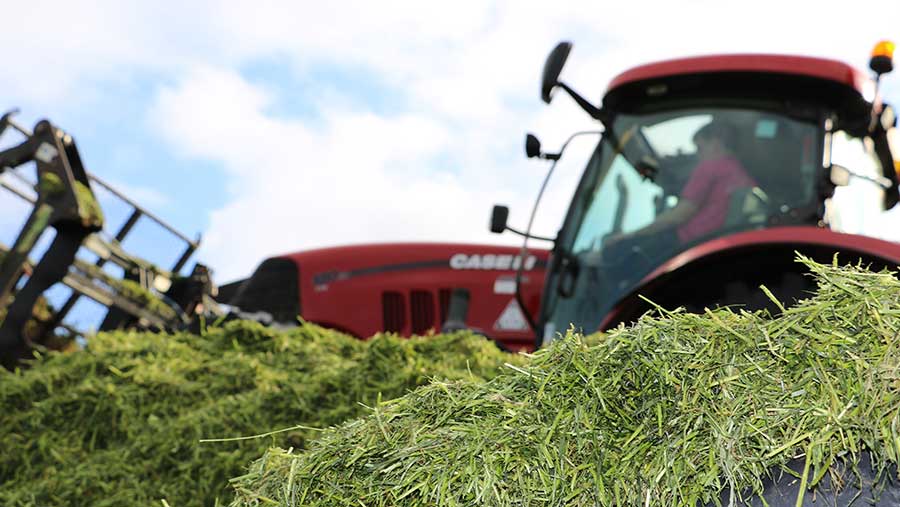First cut silage results up on 2016

There is potential to increase production from grass silage this year, with initial results from more than 1,000 first cut samples showing metabolizable energy (ME) and crude protein levels of 11.2MJ and 15.2% respectively.
Quality is up on last year, with analysis from Trouw Nutrition showing:
- Dry matter (DM) content is higher at 33.7%, while crude protein has risen from 14.5% to 15.2%
- D value is 70.1%, up from 67.6% last year, helping ME to rise from 10.8MJ to 11.2MJ
- Intake potential has also risen to 105.5, suggesting cows can be expected to eat reasonable quantities.
See also: Benefits of switching to a multi-cut silage system
Tom Goatman, ruminant nutrition at Trouw Nutrition GB, believes many dairy farmers have reaped the benefits of following advice to cut earlier to improve quality.
“Our initial results show that, on average, grass silage quality has improved, principally as a result of cutting dates being brought forward,” he said.
He added that grass growth was also slower in the spring, which meant crops were less mature at harvest – another reflection of the good analysis.
Production potential
However, farmers are being advised to use the latest parameters as a guide when formulating rations.
They are more accurate than traditional measures that undervalue forage potential and therefore could save farmers money on purchased feed, says Mr Goatman.
While traditional terms such as ‘dry matter’ and ‘crude protein’ may describe the quality of the silage in the clamp well, they do not illustrate how the silage will behave once the cow has eaten it and it has been broken down into the end products of digestion, he explains.
Dynamic Energy (DyNE), one of the new parameters produced as part of the NutriOpt dairy rationing system, is the sum of the end products of digestion, giving the most accurate assessment of the energy actually used by the cow.
Rationing on ME versus DyNE
Based on ME values, a cow consuming 10kgDM of this year’s average silage could be expected to give M+7.4 litres per day, up from 6.6 litres per day last year. Over a 200-day winter this would be an extra 160 litres from forage per cow.
However, with rationing using DyNE, a cow eating 10kgDM will be expected to produce 7.7 litres per day from silage, which is more than that anticipated using ME.
“Rationing on ME actually undervalues the potential of this year’s higher quality forage and could result in unnecessarily higher production costs,” warns Mr Goatman.
Rumen health
This year’s silages have less neutral detergent fibre (NDF), which is reflected in a lower level of slowly fermentable carbohydrate, although the level of rapidly fermentable carbohydrate has increased.
Mr Goatman says this change is good news because, for optimum digestive efficiency, the supply of carbohydrate and protein in the rumen needs to be in balance.
However, the high acid load and low fibre index suggest that rumen health may be an issue and is a reflection of the higher levels of rapidly fermentable carbohydrate and lower levels of digestible fibre.
Mr Goatman says it will pay to feed more slowly fermentable carbohydrate sources such as soya hulls and sugar beet this winter, to support rumen health.
“Overall, the average grass silage will feed well and give a chance to increase production from forage this winter and act as the foundation for more cost-effective diets,” he says.
“As usual, there is a tremendous range around the average, so the start point must be to get clamps analysed regularly to ensure diets are formulated based on the forage actually being fed.”
Comparison of initial first cut analysis 2016 and 2017 |
||
|
2016 first cut average |
2017 first cut average |
|
|
Dry matter (%) |
31.2 |
33.7 |
|
Crude protein (%) |
14.5 |
15.2 |
|
D value (%) |
67.6 |
70.1 |
|
ME (MJ/kgDM) |
10.8 |
11.2 |
|
pH |
4.1 |
4.3 |
|
Sugar (%) |
2.7 |
2.9 |
|
NDF (%) |
50.0 |
44.2 |
|
Intake potential (g/kgML) |
98.5 |
105.5 |
NutriOpt analysis parameters |
|
|
|
2017 first cut average |
|
Dynamic energy (MJ/kgDM) |
6.1 |
|
Rapidly fermentable carbohydrate (g/kg) |
200.3 |
|
Total fermentable carbohydrate (g/kg) |
440.0 |
|
Rapidly fermentable protein (g/kg) |
96.5 |
|
Total fermentable protein (g/kg) |
111.1 |
|
Acid load |
50.5 |
|
Fibre index |
178.8 |
